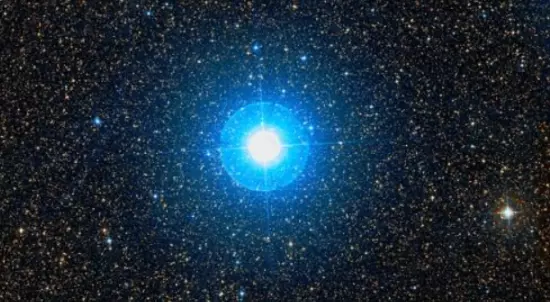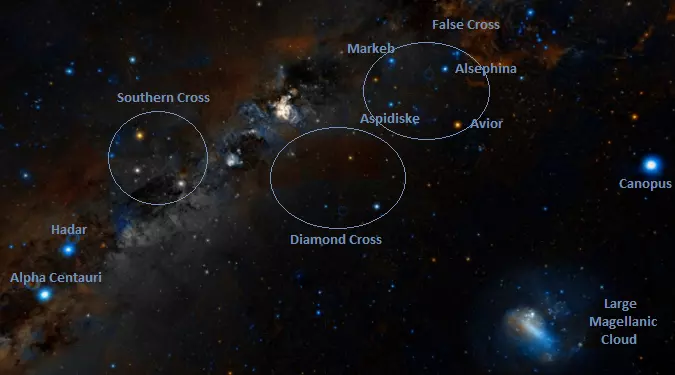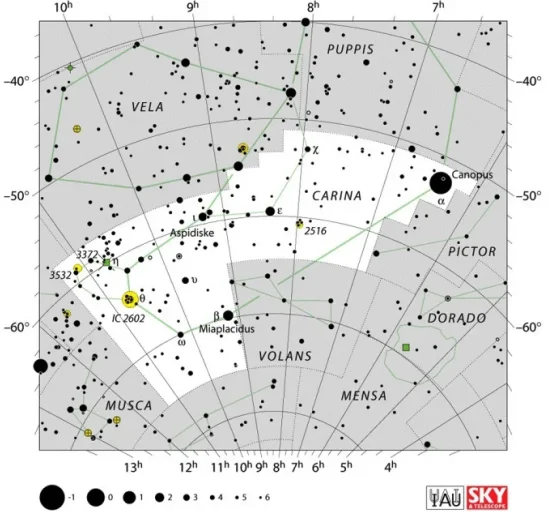Aspidiske, Iota Carinae (ι Car) is a white supergiant star located 690 light years away in the southern constellation Carina. With an apparent magnitude of 2.21, it is the fourth brightest star in Carina, after Canopus, Miaplacidus, and Avior. Aspidiske is one of the four bright stars that form the False Cross, a prominent southern asterism often mistaken for the Southern Cross.
Star type
Aspidiske is a white supergiant of the spectral type A7Ib or A9Ib. The “b” suffix indicates a lower-luminosity supergiant. With an effective temperature of 7,500 K, it is sometimes listed as a class F0 star.
Aspidiske has a mass 7.4 times that of the Sun and a radius 43 times solar. It is 4,900 times more luminous than the Sun. With a projected rotational velocity of 10 km/s it completes a rotation in less than 215 days. The star’s estimated age is only 37.4 million years.
Even though Iota Carinae is still a young star, it has evolved quickly due to its high mass and will not have a very long life. It is, however, not massive enough to meet its end as a supernova. Instead, it will go out as a white dwarf surrounded by a planetary nebula created from material expelled from the star in its final stages.
Iota Carinae is a suspected variable star. Its luminosity has been observed to vary, causing variations in brightness from magnitude 2.23 to 2.28.

Aspidiske (Iota Carinae), image: Wikisky
Facts
Aspidiske forms the False Cross with Avior (Epsilon Carinae), Alsephina (Delta Velorum), and Markeb (Kappa Velorum). The False Cross is one of three diamond-shaped asterisms in the far southern sky. It is fainter and larger than the Southern Cross, but brighter than the nearby Diamond Cross. It got its name because it is often confused for the Southern Cross, which is used to find the south celestial pole. Mistaking the two can cause errors in astronavigation.

The False Cross, image: Wikisky
The False Cross will make a better marker of true south in about 7,500 years, when the south celestial pole passes through this area of the sky. Around the year 8100 CE, Aspidiske will become the South Star. It will be succeeded by its False Cross neighbour Alsephina (Delta Velorum) around 9200 CE.
Name
The name Aspidiske (pronunciation: /ˌæspɪˈdɪskiː/) comes from the Greek word for “little shield” (ασπίδα). Iota Carinae was traditionally also known as Turais and Scutulum, which are Arabic and Latin words of the same meaning. The name Tureis now formally applies to the bright giant Rho Puppis. The name of the yellow supergiant Xi Puppis, Azmidi (or Asmidiske), is a misspelling of Aspidiske.
The name Aspidiske was approved by the International Astronomical Union’s (IAU) Working Group on Star Names (WGSN) on July 20, 2016.
In Chinese astronomy, Aspidiske was known as 海石二 (Hǎi Shí èr), the Second Star of Sea Rock. Sea Rock was an asterism formed by Iota Carinae with Avior (Epsilon Carinae), h Carinae (HD 83183), l Carinae (HD 84810), and Upsilon Carinae.
Location
Aspidiske is easy to find because it is fairly bright and part of a conspicuous southern asterism, the False Cross. It is the nearest of the four stars of the False Cross to the Diamond Cross and the Southern Cross.

The location of Alsephina, Avior, Markeb and Aspidiske, image: Wikisky
Aspidiske can be used to find the globular cluster NGC 2808 in Carina. A line extended from Markeb, the faintest star of the False Cross, through Aspidiske leads to the cluster. NGC 2808 is one of our galaxy’s most massive clusters. With an apparent magnitude of 6.2, it can be observed in binoculars. It lies approximately 31,300 light years away.

Deep sky objects near the False Cross, image: Wikisky
Constellation
Aspidiske is located in the constellation Carina. Circumpolar to southern observers, Carina is the 34th largest constellation in the sky, occupying an area of 494 square degrees. It is one of the more conspicuous southern constellations, with six stars brighter than magnitude 3.00. Some of these stars form the two prominent southern asterisms: the False Cross and the Diamond Cross.
Carina represents the keel of the ship Argo, on which Jason and the Argonauts sailed to Colchis to retrieve the Golden Fleece. Since antiquity, the mythical ship was represented by the larger constellation Argo Navis (the Ship Argo), which was once the largest constellation in the sky. Argo Navis was divided into three smaller constellations – Carina (the Keel), Vela (the Sails), and Puppis (the Stern) – by the French astronomer Nicolas-Louis de Lacaille in the 18th century.

Carina constellation map by IAU and Sky&Telescope magazine
Carina is best-known for hosting the white bright giant Canopus (Alpha Carinae), the second brightest star in the sky (after Sirius), and the vast Carina Nebula (NGC 3372), which contains the famous variable star Eta Carinae. Other notable stars in the constellation include the white giant Miaplacidus (Beta Carinae), the orange giant Avior (Epsilon Carinae), and the massive blue star Theta Carinae, the brightest member of the Theta Carinae Cluster (IC 2602), nicknamed the Southern Pleiades.
In addition to the Carina Nebula and IC 2602, bright deep sky objects in Carina include the globular cluster NGC 2808 and the open clusters NGC 2516 (the Southern Beehive, mag. 3.8), NGC 3114 (mag. 4.2), the Gem Cluster (NGC 3293), and the Wishing Well Cluster (NGC 3532), the first deep sky object to be observed by the Hubble Space Telescope. Carina also hosts the Statue of Liberty Nebula (NGC 3576) and the Bullet Cluster, a pair of two colliding galaxy clusters 3.7 billion light years away.
The best time of year to observe the stars and deep sky objects in Carina is during the month of March. The entire constellation is visible from locations between the latitudes 20° N and 90° S.
The 10 brightest stars in Carina are Canopus (Alpha Car, mag. -0.74), Miaplacidus (Beta Car, mag. 1.69), Avior (Epsilon Car, mag. 1.86), Aspidiske (Iota Car, mag. 2.21), Theta Carinae (mag. 2.76), Upsilon Carinae (2.97), Omega Carinae (mag. 3.29), PP Carinae (p Car, mag. 3.22 – 3.55), V337 Carinae (q Car, mag. 3.36 – 3.44), and V357 Carinae (a Car, mag. 3.41 – 3.44).
Aspidiske – Iota Carinae
| Spectral class | A9Ib or A7Ib |
| Variable type | Suspected |
| U-B colour index | +0.16 |
| B-V colour index | +0.18 |
| Apparent magnitude | 2.21 |
| Absolute magnitude | -5.1 |
| Distance | 690 ± 70 light years (210 ± 20 parsecs) |
| Parallax | 4.26 ± 0.10 mas |
| Radial velocity | 13.3 km/s |
| Proper motion | RA: −18.86 ± 0.09 mas/yr |
| Dec.: +11.98 ± 0.09 mas/yr | |
| Mass | 7.4 M☉ |
| Luminosity | 4,900 L☉ |
| Radius | 43 R☉ |
| Temperature | 7,500 K |
| Metallicity | -0.14 dex |
| Age | 37.4 ± 5.1 million years |
| Rotational velocity | 10.0 km/s |
| Surface gravity | 2.40 cgs |
| Constellation | Carina |
| Right ascension | 09h 17m 05.4068572s |
| Declination | −59° 16′ 30.835305″ |
| Names and designations | Aspidiske, Iota Carinae, ι Car, HD 80404, HR 3699, HIP 45556, PPM 337789, SAO 236808, FK5 351, GC 12831, GCRV 6067, CD−58°2529, CPD−58°1465, PLX 2222.10, NSV 04444, IRAS 09157-5903, 2MASS J09170540-5916308, UBV 8888, TYC 8595-3312-1 |